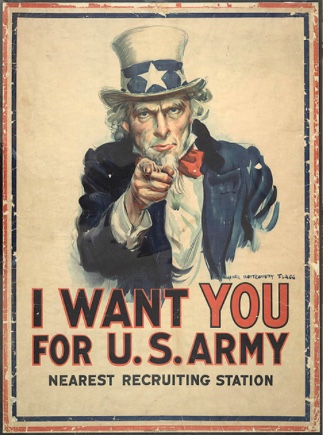Marketing World War I Through Posters: An Exhibition that Feels Frighteningly of the Moment

The first things you notice about the exhibit Posters and Patriotism: Selling World War I at the Museum of the City of New York are the huge black and white photographs of soldiers going off to war in lengthy parades and citizens marching to support the war. They are at the entrance to the exhibit and decorate the walls of it inside. They stir up your senses and ignite your patriotism and do a marvelous job of setting the stage for a wonderful exhibit of richly colored posters that were used to pump up the American public to help win the conflict in Europe.
The exhibit at the museum, at Fifth Avenue and E. 104th Street, that commemorates the beginning of U.S. involvement in the war 100 years ago, is in a huge, high ceiling room. The posters are enormous, many six feet in height, and are raised up on the walls, looming over the rest of the exhibit in striking fashion.
The exhibit is not just photos and posters, though. It includes some interesting sheet music of patriotic songs from that era with bright colored covers, such as half a dozen tunes by Irving Berlin (such as the snappy How I Hate to Get Up in the Morning) and the classic song Over There by George M. Cohan. There are magazines, flyers and poems, too, many castigating the German soldiers, referred to by all with great disdain as “the Huns.”
Whitney Donhauser, the Ronay Menschel Director of the Museum, said the posters are meant to show great art work from the war, but also to show people how the government, and private enterprise “sold” the war. "In these striking posters and artworks – designed by New York City artists and meant to inspire the entire nation – we are reminded that manufactured patriotism and selling the public is nothing new, at least to New Yorkers. This exhibition helps us confront challenging themes that are part of our nation’s history and have never completely faded into the past," she said.
World War I began for the U.S. on April 6, 1917. The nation had been conflicted over entering the war, which started in 1914, but in 1917 plunged into it. The government hired professional commercial artists to make poignant and beautiful posters to market the war and raise money, food and clothing for its victims. Organizations like the Red Cross and YWCA joined in. In an artistic landslide, they produced 2,500 different posters and 20 million of them were mass-manufactured and put on walls all over the nation. Many were quite famous, such as the Uncle Sam Wants You! and the Tell That to the Marines, with a muscular man taking his shirt off, ready to fight
America was a nation of immigrants then, as it is now, and many had come to our shores from the countries with which we were then at war. Posters asked members of those ethnic groups if they were “100% Americans” in order to get everyone to join the fight together. Other posters sold war bonds to the public (an enormous source of funding in both World War I and II).
Many of the posters are in foreign languages and designed to appeal people from a certain country, such as Czechoslovakia. A Czech typographer, Vojtech Preissig, produced a lengthy series of “support the nation” type posts that appealed to all Czechs living in the U.S. There is a nifty posters from the Jewish Welfare Board that in Yiddish tells Jews to support the war.
The Germans were dreaded villains in all the posters. One featured a bloody hand and under it a warning to ‘blot out the Hun.” The Germans here in the U.S. were always suspected of collaboration with the Germans back home and illegal German immigrants had to be finger printed by the police (photo in exhibit).
One intriguing display shows “dazzle” art. That is the camouflage type art that British artist Norman Wilkinson and others painted on the hulls of ships to confuse the torpedo officers on U-Boats trying to sink them.
Women were featured in many and the museum claims, probably correctly, that the huge and very public women’s support of the war may have helped them to win the vote just after its conclusion. The YWCA, as an example, had a whole series of posters to remind people of that organizations prodigious work in the war (there is a complete YWCA workers uniform on display near the group’s posters). The YWCA artists, and the organization ‘s leaders, created a heroic “Victory Girl” to help fight the war and remind all that it was a combination of men and women against the enemy. The Red Cross posters usually featured brave nurses helping someone.
The exhibit features 60 posters from the museum’s collection, donated to it by railroad executive John Campbell in 1943. Many are on display for the first time.
The exhibit is sponsored by the Robert Dinan Memorial Fund Cultural Services of the French Embassy, the Susan and Elihu Rose Foundation and other groups. It will be on display through October 9.